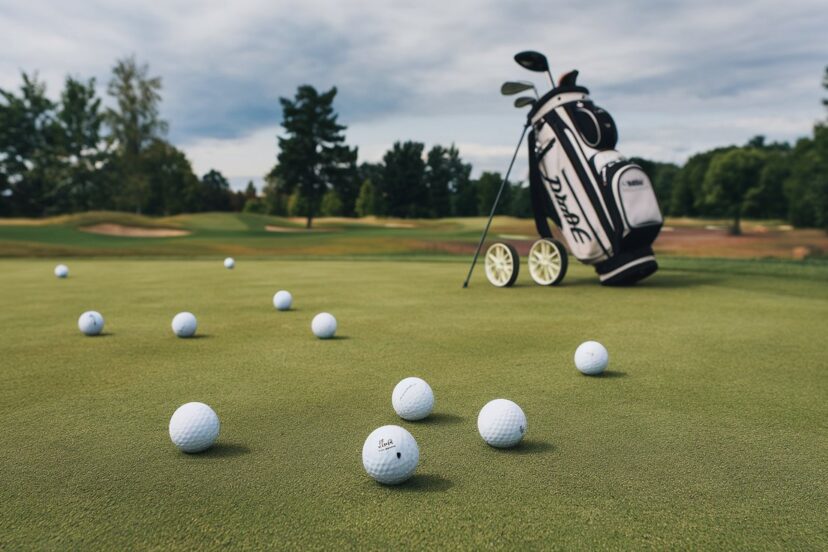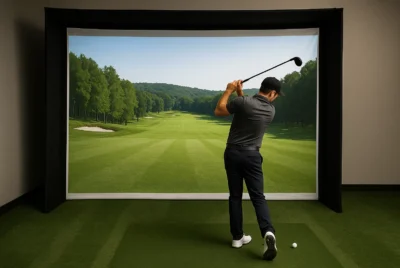Best Golf Balls for High Handicappers
*We may earn a commission for purchases made using our links. Please see our disclosure to learn more.
Finding the right golf ball can be a game-changer for high handicap players. While professional golfers might scrutinize every technical aspect of their equipment, recreational players with higher handicaps need the best golf balls for high handicappers, options that offer forgiveness, distance, and consistency to help lower their scores and boost their confidence on the course.
Key Takeaways
- High handicappers benefit most from golf balls designed for maximum forgiveness and distance
- Two-piece construction balls typically offer the best combination of durability and performance for developing players
- Lower compression golf balls help slower swing speeds generate more distance
- Choosing a ball with minimal sidespin helps reduce slices and hooks
- Price is important—find a balance between performance and value as you’ll likely lose more balls while improving
“The golf ball is the most important piece of equipment in the game. It’s the only piece of equipment used for every shot, yet most amateurs don’t put enough thought into finding the right ball for their game.”
— Dave Phillips, Co-Founder of the Titleist Performance Institute
Best Golf Balls for High Handicappers
After extensive research and testing, here are four standout options that truly represent the best golf balls for high handicappers. These picks are designed to help improve your game by offering distance, forgiveness, and feel, while also delivering solid value for your money:
1. Callaway Supersoft
The Callaway Supersoft Golf Balls are designed for golfers seeking exceptional distance, ultra-soft feel, and enhanced control. With a low compression core and HEX Aerodynamics, these balls promote longer, straighter shots and a higher launch—ideal for high handicappers aiming to improve their game. Available in a variety of colors and fun designs, they combine performance with personality.
- Soft Feel: Ultra-low compression core delivers a super soft feel on every shot.
- Increased Distance: HEX Aerodynamics reduce drag and enhance lift for longer carry.
- Great Value: High-quality performance at an affordable price.
- Low Spin Control: May lack precision around the greens for advanced players.
- Durability: Softer cover can scuff more easily than harder balls.
- Limited Feedback: Very soft feel may reduce feedback for some golfers.
Best Overall for High Handicappers
The Callaway Supersoft has earned its reputation as an excellent all-around performer for golfers still developing their skills. With an ultra-low 38 compression rating, this ball helps players with moderate swing speeds achieve maximum distance without sacrificing too much control. The soft feel provides excellent feedback on putts and short game shots, while the HEX Aerodynamics pattern reduces drag for longer, straighter flights.
What makes the Supersoft particularly appealing for high handicappers is its forgiving nature off the tee. The low-spin design helps minimize those frustrating slices and hooks that plague many developing players. While more advanced golfers might desire additional spin control around the greens, high handicappers will appreciate the overall consistency this ball provides across all facets of the game.
The Supersoft’s vibrant color options also provide a practical benefit for high handicappers, increased visibility. The bright matte finish options make it easier to track your ball in flight and find it in rough or wooded areas, which can save strokes and reduce frustration during a round.
Durability is another significant advantage. The Supersoft’s cover material offers impressive resistance to cuts and scuffs, ensuring your ball maintains performance even after encounters with trees, cart paths, or other hazards that high handicappers might face more frequently.
2. Titleist TruFeel
The Titleist TruFeel Golf Balls are crafted for golfers who want the trusted performance of Titleist with a soft feel and consistent distance. Featuring a new TruTouch core, low-drag aerodynamics, and a softer TruFlex cover, these balls deliver long, penetrating flight and enhanced greenside control. Ideal for high handicappers and feel-focused players alike.
- Soft Feel: TruTouch core offers a cushioned, responsive impact.
- Enhanced Control: Softer cover improves greenside spin and shot-stopping ability.
- Penetrating Flight: 376 dimple design promotes stable, low ball flight.
- Lower Spin Off Driver: May not provide enough spin for players needing more carry.
- Less Forgiving: Not as forgiving on mishits compared to some beginner-friendly balls.
- Limited Color Options: Fewer fun designs compared to other brands.
Best for Feel and Control
Titleist’s reputation for quality extends beyond their premium Pro V1 line. TruFeel represents their most affordable option without compromising the brand’s commitment to performance. The TruFeel features a proprietary TruTouch core and TruFit aerodynamics that deliver impressive distance with a remarkably soft feel.
High handicappers who struggle with generating power off the tee will appreciate the distance gains, while those working on their short game will benefit from the soft feel that provides excellent feedback around the greens. The TruFeel’s thin cover design also offers better durability than many competitors in this price range, an important consideration for players who might be losing more balls while developing their skills.
What separates the TruFeel from other budget-friendly options is Titleist’s attention to detail in the manufacturing process. The consistent quality control ensures you’ll get predictable performance from every ball in the box, something that can’t be said for all value-oriented options. This consistency helps high handicappers develop more reliable expectations about how their equipment will perform, which is crucial for building confidence and improving scores.
The TruFeel’s aerodynamic design also helps produce a penetrating ball flight that performs well in windy conditions. This characteristic can be particularly beneficial for high handicappers who don’t have the skill to adjust their shots to compensate for challenging weather.
3. Wilson Staff Duo Soft+
The Wilson 2025 Duo Soft Golf Balls are engineered for players seeking an ultra-soft feel without sacrificing distance. With a high-energy core and reduced spin design, these balls offer a straighter flight and better control off the tee. Ideal for high handicappers looking to add consistency and comfort to their game.
- Ultra-Soft Feel: Industry-leading softness enhances feedback and comfort.
- Long Distance: High-energy core delivers excellent carry and yardage.
- Straight Flight: Low spin helps reduce slices and hooks.
- Limited Spin Control: May lack the greenside spin desired by advanced players.
- Basic Design: Simple two-layer construction may not suit all play styles.
- Lower Visibility: White version may be harder to track in the air or rough.
Best Budget Option
The Wilson Staff Duo Soft+ stands out with its remarkably low 35 compression rating, among the lowest in the market. This makes it exceptionally forgiving for players with slower swing speeds, allowing them to generate more distance without needing to swing harder. The two-piece construction optimizes energy transfer while the VelocitiCOR technology helps maintain ball speed even on off-center hits.
What high handicappers will particularly appreciate is the ball’s straight flight characteristics. The reduced spin off the driver helps minimize those frustrating slices and hooks. While advanced players might desire more workability, the Duo Soft+ prioritizes keeping the ball in play, exactly what developing golfers need. The affordable price point makes this an excellent choice for golfers still building consistency in their game.
Wilson’s focus on value doesn’t mean compromising on innovation. The Duo Soft+ incorporates technology typically found in more expensive models, including a seamless 302 dimple pattern that optimizes lift and reduces drag for maximum carry distance. This technical design helps compensate for the moderate swing speeds common among high handicappers.
The ball’s durability is another significant advantage. The ionomer cover material stands up well to the rigors of tree hits, cart path bounces, and other mishaps that high handicappers might encounter more frequently. This resilience ensures you’ll get maximum value from each ball before needing to retire it from play.
4. Srixon Soft Feel
The Srixon Soft Feel Golf Balls are built for golfers who want a perfect blend of softness, distance, and control. Featuring a FastLayer Core that transitions from soft to firm and a 338 Speed Dimple Pattern for optimal aerodynamics, these balls deliver impressive distance with a soft feel and reliable greenside spin—ideal for high handicappers seeking consistency and comfort.
- Soft Yet Long: FastLayer Core delivers a soft feel with impressive distance.
- Wind Performance: 338 dimple pattern enhances flight stability in windy conditions.
- Greenside Spin: Thin cover improves control on short shots.
- Not Tour-Level Spin: May lack advanced spin needed by low handicappers.
- Durability: Softer cover may wear quicker than harder options.
- Less Feedback: Very soft feel might reduce impact feedback for some players.
Best for Slower Swing Speeds
The Srixon Soft Feel is specifically designed with moderate swing speeds in mind. The FastLayer core provides excellent energy transfer while maintaining the soft feel that gives the ball its name. A 338 Speed Dimple Pattern helps reduce drag during flight, helping the ball cut through the air more efficiently for added distance.
High handicappers will benefit from the ball’s overall forgiveness and consistent performance across various shot types. The soft compression core is particularly beneficial on tee shots, helping players with slower swing speeds maximize their distance potential without swinging out of their shoes. Around the greens, the thin cover provides adequate feel for chips and putts without demanding the precise contact that more tour-level balls require.
Srixon’s engineering approach focuses on optimizing the entire ball rather than just specific aspects. The gradual transition from soft inner core to firmer outer core helps create an ideal energy transfer at impact, providing excellent response across varying swing speeds common among high handicappers. This design philosophy makes the Soft Feel a versatile option that can adapt to different aspects of your game as you develop.
The Soft Feel’s alignment aid is another thoughtful feature for developing players. The simple yet effective marking helps ensure proper alignment on the putting green, an often-overlooked aspect of scoring that can significantly impact a high handicapper’s performance.
Understanding What Makes a Golf Ball Suitable for High Handicappers
When shopping for golf balls as a high handicapper, it’s helpful to understand the basic characteristics that influence performance and how they relate to your game.
Construction Types
Most golf balls for high handicappers feature a simpler construction compared to tour-level options:
- Two-Piece Construction: These balls have a large core covered by a durable outer layer. This design maximizes distance and durability while minimizing spin, ideal characteristics for high handicappers. All four of our recommended balls feature this player-friendly construction.
- Multi-Layer Construction: As players improve, they might graduate to three, four, or even five-piece balls that offer more specialized performance characteristics. However, these balls typically demand more consistent swing mechanics to unlock their benefits and can actually hurt performance for high handicappers.
Compression Ratings
Compression refers to how much the ball deforms at impact:
- Low Compression (below 70): Perfect for high handicappers with moderate swing speeds. These balls compress more easily at impact, helping generate distance even without tour-level swing speeds. The Callaway Supersoft (38), Wilson Duo Soft+ (35), and Srixon Soft Feel (60) all feature low compression ratings ideal for developing players.
- Mid Compression (70-90): These balls offer a balance of distance and control suitable for improving mid-handicappers who have developed more consistent swing mechanics.
- High Compression (above 90): Typically used by low handicappers and professionals with faster swing speeds. High handicappers should generally avoid these balls as they won’t compress properly with moderate swing speeds.
Spin Characteristics
Different golf balls produce varying amounts of spin, which affects both distance and control:
- Low Spin: Reduces side spin on drives, helping minimize slices and hooks, a significant benefit for high handicappers who struggle with consistent ball striking. The Wilson Duo Soft+ and Callaway Supersoft excel in this category.
- Mid Spin: Offers a balance between forgiveness off the tee and some control around the greens. The Titleist TruFeel and Srixon Soft Feel provide this middle-ground performance.
- High Spin: Typically found in premium tour balls, high spin allows skilled players to shape shots and stop balls quickly on greens. However, this same characteristic can exaggerate slices and hooks for high handicappers, making these balls counterproductive for most developing players.
Matching Ball to Your Swing Speed
Your swing speed should be a primary consideration when selecting the best golf balls for high handicappers:
- Below 85 mph: If your driver swing speed falls in this range, ultra-low compression balls like the Wilson Duo Soft+ (35 compression) will provide maximum benefit by compressing fully even at moderate speeds.
- 85-95 mph: This range pairs well with low-compression options like the Callaway Supersoft (38 compression) or Srixon Soft Feel (60 compression).
- 95+ mph: As swing speeds increase, players can consider mid-compression options that offer more control while still providing distance benefits.
If you’re unsure about your swing speed, most golf retailers offer measurement services. Alternatively, you can estimate based on your typical driver distance, if you’re hitting under 230 yards consistently, you likely fall into the sub-95 mph category where lower compression balls will perform best.
Finding Value: Performance vs. Price
As a high handicapper, you’re likely to lose more balls during a round than lower handicap players. This reality makes cost an important consideration:
The Wilson Staff Duo Soft+ offers exceptional value at around $25 per dozen, making it an ideal choice for budget-conscious players or those who tend to lose multiple balls per round. The Callaway Supersoft ($29-32) and Srixon Soft Feel ($27-30) represent the mid-range price point, while the Titleist TruFeel ($30-35) sits at the premium end of our recommendations.
Consider purchasing in bulk or watching for seasonal sales to maximize value. Many manufacturers offer “play-it-again” guarantees, allowing you to try a sleeve before committing to multiple dozen, a worthwhile approach as you determine which characteristics best suit your game.
When to Consider an Upgrade
As your skills improve and your handicap drops, your equipment needs will evolve. Signs that you might benefit from transitioning to a more advanced golf ball include:
- Consistently breaking 90 on your home course
- Developing more consistent swing mechanics
- Noticing your drives travel too high with excessive spin
- Desiring more control for approach shots and around the greens
When these indicators appear, consider testing balls with three-piece construction or slightly higher compression ratings that offer more workability while maintaining reasonable forgiveness.
Conclusion
Selecting the right golf ball is an essential, yet often overlooked, part of equipment choice for high handicappers. While driver fittings and putter selections may grab more attention, finding a ball that matches your swing characteristics can quickly improve distance, accuracy, and overall confidence.
The Callaway Supersoft earns our top recommendation among the best golf balls for high handicappers, offering a well-balanced blend of distance, soft feel, and forgiveness, all at a reasonable price point. That said, any of the four options we’ve highlighted represent strong choices that can outperform mismatched gear or constantly switching between ball types.
Above all, remember that consistency is key. Sticking with a golf ball that suits your game helps you develop reliable expectations and a stronger connection with your equipment. That trust builds confidence, and confidence leads to lower scores and more fun on the course.
Frequently Asked Questions
How much does golf ball selection matter for high handicappers?
While technique and practice remain the most important factors for improvement, playing a golf ball suited to your skill level can save 3-5 strokes per round by reducing penalties from slices, hooks, and lost balls. The right ball also builds confidence, leading to better decision-making on the course.
Should high handicappers use the same ball pros use?
Generally no. Tour-level balls like the Titleist Pro V1, TaylorMade TP5, or Callaway Chrome Soft are designed for players with faster swing speeds and more consistent contact. These balls typically feature higher compression ratings and spin characteristics that can actually harm performance for developing players.
How often should I change golf balls during a round?
For high handicappers, ball condition matters less than consistency. Unless your ball has visible damage like cuts or chunks missing from the cover, continuing with the same ball helps build familiarity with how it performs. That said, if your ball takes a hard impact with a tree or cart path, inspect it for damage that might affect flight characteristics.
Will using a “distance” ball help my game as a high handicapper?
Distance-focused balls like the Supersoft and Duo Soft+ can indeed help, but not solely because they travel farther. Their low-spin characteristics reduce side spin, keeping more shots in play, often a greater benefit than the extra 5-10 yards they might provide. Staying in bounds consistently will improve scores more than an occasional extra few yards of distance.
For most high handicappers, the performance benefits of premium balls ($45+ per dozen) don’t justify their cost. The balls we’ve recommended offer 90% of the performance at 60-70% of the price. As your skills improve and you lose fewer balls per round, upgrading to premium options becomes more economically viable.
















